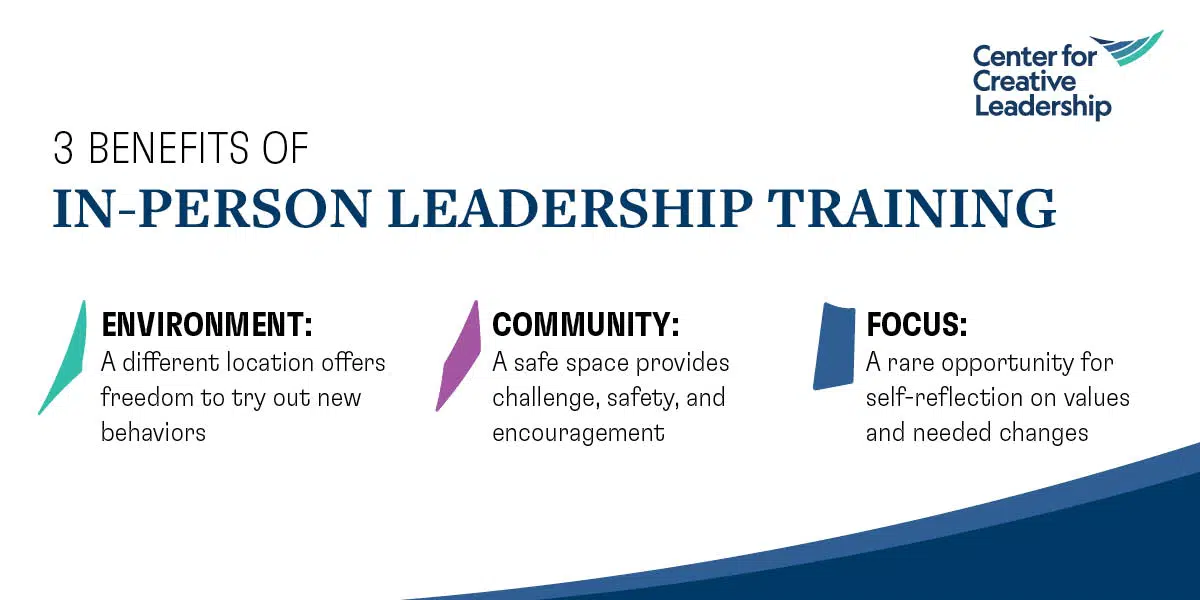All development is self-development. It’s never something that’s done to someone.
We need systems and programs to create frameworks and opportunities for development, but if we neglect the personal commitment of the individuals involved, development will flounder.
If participants aren’t motivated to grow, the effects of any training will be minimal, superficial, and transient. We must remember that every kind of leadership development program should incorporate a personal element, and no single thing works for everyone.
That’s why effective approaches to leadership development will always require a range of modalities and experiences. While online learning can be highly (even surprisingly) effective, in-person leadership training is the right choice in key situations.
Here are 2 case studies that illustrate this point.
When In-Person Leadership Training Is Most Effective
Case Study #1: An Overwhelming, Complex Challenge
Michael called us about a new vice president on his team. “She seems to have reverted to an old leadership style of hers. She’s digging into the weeds in her new division and is killing the enthusiasm that greeted her appointment only 2 months ago. Can we get her some support with coaching?”
After a little investigating, we found that this leader was overwhelmed by the collision of her expectations and the confusing mix of directions that were driving this newly combined division. Senior management expected some great synergy from the new group, but were not themselves very clear about how it would be achieved.
We told Michael: “We can give her a coach, but we think what she really needs is a week away from the team and a chance to rethink her approach to strategic leadership. Send her to one of our leadership programs for senior executives, and we think she’ll have a chance to get focused on the right level of intervention and figure out her own way to manage the competing pressures. If she wants a coach to help process that, let’s do that after she’s been given the space to exercise the talent you see in her.”
Why in-person leadership training for this situation?
The pressure of a new position, especially one that is subject to multiple forces with differing interests, allows almost no time for real thoughtfulness or introspection. And real thought is the most precious and powerful resource an effective leader needs in this situation. An in-person leadership development program can provide a leader with the time and space to reflect and grow.
The leader can also benchmark her leadership competencies against those of different industries and sectors. The sense of community built into a week-long program away from the workplace, and the focus on strategy and reflection, will help her develop the tools needed to be a more well rounded leader when she returns.
Results: The in-person leadership training opportunity worked. Away from her workplace, she recalibrated her ability to focus on what was really important. She remembered that strategy is a learning process and she was able to create a set of steps to involve her people and stakeholders in her development. They came together over a common view of the opportunities and challenges presented.
She did work with a coach, primarily to help her team improve in honest, solution-oriented communication. Michael told us later that her team members were less anxious and reduced their complaints dramatically.
Case Study #2: A Dynamic & Difficult Situation
We spoke with Divya about the custom leadership development program we co-created with her for director-level leaders. Over the 3 years we worked together, her organization found that having a common language to talk about leadership, a set of core values driving their leadership strategy, and support for skill development paid off in important business and reputation results.
Divya was concerned about a few people for whom the program didn’t seem to click. One director in particular had a negative reputation and was viewed by others as disruptive. He was seen as hard to work with, and peers and direct reports often used words like “rude” and “insensitive” to describe him. He participated in the company’s program, but did not seem to gleam the same learnings as others did.
We suggested, “Though challenging, he delivers on business objectives and customer expectations. Instead of letting him go, let’s offer him a leadership development experience based on self-awareness, and see if we can help him manage his toxic leadership style.”
Divya sent him to a leadership training in-person session of our flagship Leadership Development Program (LDP)® in Brussels. The key enticement was a chance to really increase his own satisfaction by focusing on maximizing his strengths, as this program gives participants a chance to see themselves in a completely new light and discover undeveloped aspects of their leadership repertoire.
Why in-person leadership training for this situation?
We often overestimate the quantity and quality of feedback that a “problem leader” is receiving. There are many social dynamics in the workplace that hinder direct, helpful communication. Sometimes the only way to get someone’s attention (without punishing them) is to send them away for an experience, so they can focus on their development without distractions.
Also, a leadership development effort that focuses on increasing a leader’s capacity to uncover and respond to how they’re being experienced has long-term benefits as the challenges change. Learning how to learn begins with the understanding that you need to seek out information about your impact.
Results: So far, attending LDP paired with follow-up coaching has turned the director into a more thoughtful leader. It’s still early, but he now has the insight that his focus had been only on short-term results. After the program, he said, “I realized I need to balance short- and long-term results … and long-term results require more digging into the thinking and wisdom of my people and my colleagues.”
It’s surprising what creating a little space and time for listening can do to help a leader create a better environment for everyone to perform more willingly.
When In-Person Leadership Training Really Works
3 Key Benefits of In-Person Leadership Development
What are the lessons? These 2 cases illustrate why in-person leadership training programs are so effective.
1. Environment: “Escaping” the typical work environment makes breakthroughs more possible and provides freedom of thought.
Whether someone is primarily working from home, in an office, or in a hybrid workplace arrangement, going to an in-person leadership program means the development occurs someplace else, not in their usual work environment. Psychologically, being in a different location opens us up to new possibilities.
When encouraging someone to make a significant change in thinking and behaving, a new environment may be essential. Leaders who operate in a highly complex environment or grapple with complicated challenges often reflexively immerse themselves even deeper into those challenges to try to resolve them. But sometimes what they need most is the opposite — to temporarily step back from typical day-to-day challenges to re-focus on the bigger picture.
There is also an element of freedom that comes with participating in training and development courses away from one’s usual environment. Participants attending leadership training in-person may come from different parts of the same organization, or from totally different organizations, industries, cultures, and even countries, and may likely never see each other again.
The impact on a participant is that they’re exposed to new thought patterns and ideas and are free to try new ways of thinking and behaving that they may not have felt comfortable exploring in their usual workplace setting.
2. Community: Connecting with peers in a safe space fosters insights and support for change.
A measured environment of challenge, along with plenty of support, can provide the right balance of safety and encouragement. Over the course of an in-person leadership training program, participants create connection, come to care about each other, and want others to do well. Physical proximity enables and reinforces deep connections, and helps to foster an environment of psychological safety in which change, including transformational change, can occur.
First-time leaders especially benefit from spending dedicated time with colleagues at their level and creating their own leadership network. The earlier in their careers they can begin to build a peer leader network, the more effective they will be in spanning boundaries and broadening their focus beyond their functional areas of expertise.
3. Focus: Thoughtful and focused development time is a rare opportunity.
For many participants, their time away at an in-person leadership training program may be a truly restful retreat, and the only sustained time they’ve paused to take a serious look at themselves in their adult working lives. The time to step away from work duties, challenging demands, and the needs of other team members can allow leaders to truly take the time to self-reflect and gain proper insight into what tools they need to develop make themselves a more effective leader.
These are the reasons that investing in in-person leadership development can be so effective, providing some unique advantages in certain situations.
Ready to Take the Next Step?
Learn more about our core leadership training programs to select the right one for your leaders.








